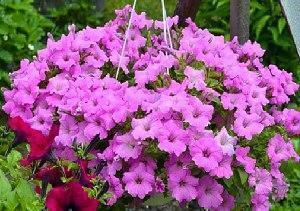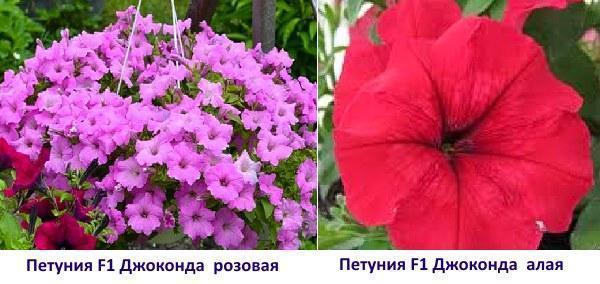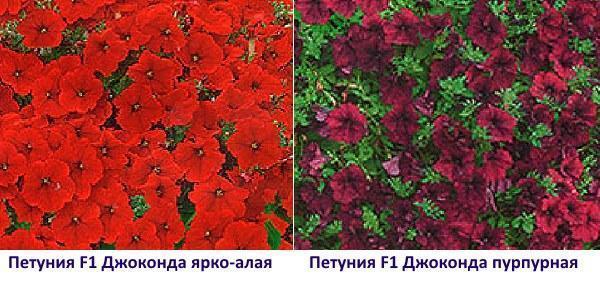Petunia Gioconda - strive for beauty
 Here you can get acquainted with:
Here you can get acquainted with:
- the newest variety of petunia F1 Gioconda, find out its individual characteristics;
- a gallery of photos of a wonderful petunia;
- petunia Gioconda multi-flowered cascading cascading;
- orange petunia;
- selection of soil and care;
Petunia F1 Gioconda is the newest hybrid petunia that has made a breakthrough in breeding. Its uniqueness lies in the fact that it is the first petunia in the world to have such a huge number of flowers. This overwhelming effect is due to male sterility, that is, such a plant is not capable of producing seeds. Gioconda blooms at an early stage of plant development, and with proper care, flowering is continuous for a year, although petunia is an annual plant.
Petunia Gioconda F1 also competes with surfinias and petunias, which propagate by cuttings. Unusual power branching stems up to 1 meter long are able to cover the soil with a flower carpet, having a height of only 20 cm. The diameter of the flower is relatively small - only 6 cm. When grown in flowerpots and pots, the shoots cascade over the edges. The value of this type of petunia is also that it is able to withstand a large temperature range from -8 to +40oC.
A phenomenal feature of the Mona Lisa is its ability to adapt to a decrease in temperature, at which the plant does not die, but only slows down its growth. It is an extremely hardy variety.
Like all petunias, Gioconda F1 is a light-loving plant, which needs 11 hours of daylight to grow comfortably. Keeping petunias in the most optimal conditions for it will prolong its flowering up to a year. This invaluable quality opens up new possibilities for gardeners.
When grown in hanging baskets and pots, Gioconda petunia competes with the best varieties ampel petunia ... The uniformity of the distribution of flowers on the branches, create lush garlands. Petunias of this variety differ in the evenness of plants both during growing seedlings and when planting in a permanent place. This invaluable quality makes it ideal for the production of seedlings in greenhouses. The plant is very strong, powerful, begins to bloom in an early period of development.
The considered variety of petunias is more resistant to rot and disease than a number of other popular varieties and hybrids. Therefore, it can be widely used in different regions with different climatic conditions.
The variety of species of Gioconda petunia is large enough. Coloring of buds happens:
- purple;
- pink;
- purple;
- scarlet;
- bright scarlet;
- orange;
- neon;
- salmon;
- white.
The photo shows various types of petunia F1 Gioconda



Petunia F1 Gioconda multi-flowered cascading cascading
This type of petunia with its beauty can compete with the ampelous petunia. But if the ampelous petunia is grown in pots and hanging baskets, then the multi-flowered cascading cascade petunia is also grown in the open field. This became possible due to the powerful, densely branched stems of the plant and the unique resistance of petunia, the Gioconda variety, to climatic changes in temperature and the ability to tolerate a humid environment in the form of rain. The resistance of this hybrid variety to root decay allows it to be grown also in the form of a chic carpet spreading in all directions.

Petunia Gioconda orange
Orange Gioconda is distinguished by its special beauty and rarity of color. Flowers 6 cm in diameter, length of branches 100 cm. It belongs to multi-flowered cascading cascading petunias. From top to bottom, strewn with bright orange-colored flowers creates a unique beauty orange cascade of meter-long powerful branches, which will attract the eye with its originality. Grown as an ammel plant in hanging baskets, pots, in pots, in the open field.

Growing the Gioconda is no different from growing all other types of petunias. Soil selection does not require any special approach. Petunia has a remarkable ability to adapt to any type of soil. But if you want to create ideal conditions for your pet, then you need to make a mixture of turf and leafy soil, add sand, rotted humus, peat and mix everything well. But it must be remembered that alkaline and highly acidic soils are contraindicated for petunias.
To ensure the acceleration of growth and abundant, long-term flowering, it is necessary to feed the plants with organic and mineral fertilizers. The interval between dressings is approximately 10-15 days.
To increase the efficiency of assimilation by the roots of the plant, fertilizing is diluted with water:
- 1 tsp / 1 l for organic fertilizers;
- 1.5 g / 1 l for mineral fertilizers.
Granular fertilizers are very convenient to use, which are simply embedded in the soil around the bush and watered. Water the soil regularly, the main thing is to prevent the soil from locking. In order for petunia to delight with its lush, delicious flowers, wilted buds should be constantly cut off, otherwise the appearance of the bush will be untidy and unkempt. This does not take much time, but you need to do it constantly. In addition, removing wilted buds encourages the development of new ones.
Tips on when to plant petunias for seedlings - read here!
Sowed last year a petunia of the Gioconda variety. Developed well throughout the spring, seedlings were friendly. The bush is kept on thick stems, does not grow bald, compact. The middle, like ordinary petunias, does not fall apart. True, the flowers were not as large as expected. When she grew up, she became like an ampelous petunia. At first she grew up in a flowerpot on the porch. When the stems lengthened, I put the flowerpot on a stool. By the fall, it has grown to the very ground - very beautiful. By the way, in the fall, when the temperature began to drop, it became much more magnificent and powerful. I want to try planting salmon and orange
I bought seedlings of Gioconda multi-flowered creeping purple and white petunia. I planted it nearby. Both are beautiful, but I especially liked the purple one. The bush acquired a decorative effect earlier, the branches are woven somehow more elegantly than that of the white one. They look very smart together. White Mona Lisa looks more beautiful at dusk, while purple in the evening seems to disappear. I will definitely plant both next year, but I want to try bright scarlet
Planted a petunia of the F1 Gioconda salmon variety. The color is kind of light pink. You often have to pick off wilted flowers, otherwise the bush looks ugly. In the second half of September, the bush became fatter and greener, and the flowers were more elegant. Simple petunias in the flowerbed began to fade, turn yellow, and this one threw out a bunch of new buds. There were frosts up to -3, at least she could. It is quite possible to plant, I recommend.
the photo "petunia orange gioconda" actually depicts a petunia "papaya" of vegetative propagation. The real La Gioconda has a white throat and the main color is red rather than orange. The photo titled "Petunia pink monochromatic pink" is actually a petunia of the Tidal variety, and the second photo with a white petunia too.
Hello. How many pieces should you plant in a large flowerpot?
Do I need to form a bush?